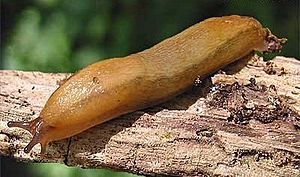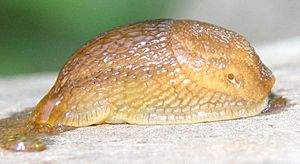Arion fuscus facts for kids
Quick facts for kids Arion fuscus |
|
|---|---|
 |
|
| An active individual from the Netherlands | |
 |
|
| A contracted individual of Arion fuscus from the Czech Republic | |
| Conservation status | |
|
NE
|
|
| Scientific classification | |
| Synonyms | |
|
Arion subfuscus (Draparnaud, 1805) |
Arion fuscus, also known as the "Dusky Arion", is a species of small air-breathing land slug, a terrestrial pulmonate gastropod mollusk in the family Arionidae, the roundback slugs.
Arion subfuscus (Draparnaud, 1805) is considered by some authors to be a partial synonym for Arion fuscus. Arion subfuscus (Draparnaud, 1805) and A. fuscus (Müller, 1774) have very similar morphology and have overlapping distributional ranges in northwestern Europe. Arion fuscus is widespread throughout Central, North and East Europe whereas A. subfuscus is restricted to West Europe. (For practical purposes the two are synonyms in Germany and in the Czech Republic.) The two taxa are referred to as the species complex Arion subfuscus/fuscus both members having several evolutionary lineages. They are only separable by alloenzyme analysis and gonad type.
Description
A 50–70 mm roundback slug. It is brown in colour, ranging from black-brown through olive-brown to orange and bright reddish-orange. Darker lateral bands are present. Dark pigment reaches under the pneumostome from back to front. The foot fringe is pale with thin lines. The sole is uniformly pale/translucent.The tentacles are pale or dark. It does not contract into a bell shape when stimulated. The Dusky Arion differs from other Arion species in its yellow-orange body mucus. Genitalia:Atrium about half diameter of spermatheca, spermatheca spherical, oviduct large and swollen like in Arion lusitanicus
Distribution
This species occurs in European and Asian countries and islands including:
- Austria
- Bulgaria
- Czech Republic - least concern (LC)
- Germany
- Netherlands
- Poland
- Slovakia
- Great Britain
- Ireland
- China
- and other areas
Habitat
This slug lives under fallen logs and under bark in woodland areas, but it also lives in hedges, gardens, pastures and dunes.

